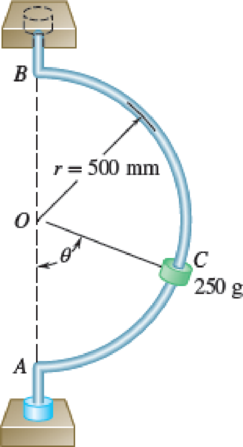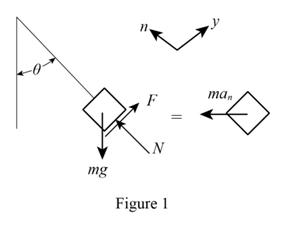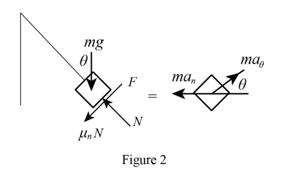
Concept explainers
A small 250-g collar C can slide on a semicircular rod which is made to rotate about the vertical AB at a constant rate of 7.5 rad/s. Knowing that the coefficients of friction are μs = 0.25 and μk = 0.20, indicate whether the collar will slide on the rod if it is released in the position corresponding to (a) θ = 75°, (b) θ = 40°. Also, determine the magnitude and direction of the friction force exerted on the collar immediately after release.
Fig. P12.64 and P12.65

(a)
Indicate whether the collar will slide on the rod if it is released in the position corresponding to angle
Find the magnitude and direction of the friction force exerted on the collar immediately after release.
Answer to Problem 12.65P
The collar does not slide on the rod if it is released in the position corresponding to angle
The magnitude and direction of the friction force exerted on the collar immediately after release is 0.611 N.
Explanation of Solution
Given information:
The mass of collar (m) is 250 g.
The speed of rotation of semi-circular rod
The radius (r) of semicircular rod is 500 mm.
The coefficient of static friction
The coefficient of kinetic friction
Calculation:
The collar will not slide. Therefore the collar moves at constant speed.
Find the equation of radius of circle for constant rotation.
Find the equation of speed of semicircular rod for constant rotation:
Find the equation of normal acceleration
Substitute
Substitute
Sketch the free body diagram and kinetic diagram of the collar C as shown in Figure (1).

Refer Figure (1):
Find the normal force (N) on the collar.
Apply Newton’s law of equation along x-axis.
Substitute
Substitute 250 g for m,
Find the frictional force (F) using Newton’s law of equation:
Apply Newton’s law of equation along y-axis.
Substitute
Substitute 250 g for m,
Find the frictional force using general equation:
Substitute 0.25 for
The frictional force
Thus, the magnitude and direction of the friction force exerted on the collar immediately after release is 0.611 N.
(b)
Indicate whether the collar will slide on the rod if it is released in the position corresponding to angle
Find the magnitude and direction of the friction force exerted on the collar immediately after release.
Answer to Problem 12.65P
The collar does not slide on the rod if it is released in the position corresponding to angle
The magnitude and direction of the friction force exerted on the collar immediately after release is 0.957 N.
Explanation of Solution
Calculation:
Find the normal force (N) on the collar using Equation (1):
Substitute 250 g for m,
Find the frictional force (F) using Equation (2):
Substitute 250 g for m,
Find the frictional force using general equation:
Substitute 0.25 for
The frictional force
Sketch the free body diagram and kinetic diagram of the collar C which is sliding as shown in Figure (2).

Refer Figure 2:
Find the normal force (N) on the collar.
Apply Newton’s law of equation along x-axis.
Substitute
Substitute 250 g for m,
Find the magnitude and direction of the friction force
Substitute 0.20 for
Thus, the magnitude and direction of the friction force exerted on the collar immediately after release is 0.957 N.
Want to see more full solutions like this?
Chapter 12 Solutions
Connect 1 Semester Access Card for Vector Mechanics for Engineers: Statics and Dynamics
Additional Engineering Textbook Solutions
Heating Ventilating and Air Conditioning: Analysis and Design
Engineering Mechanics: Statics & Dynamics (14th Edition)
Fundamentals of Aerodynamics
Mechanics of Materials (10th Edition)
Machine Elements in Mechanical Design (6th Edition) (What's New in Trades & Technology)
Vector Mechanics for Engineers: Statics, 11th Edition
- Pin B weighs 0.1kg and is free to slide in a horizontal plane along therotating arm OC and along the circular slot DE of radius b=500mm.Neglecting friction and assuming that θ= 15 rad/s andθ=250 rad/s2 for the position θ= 20o , determine for that position(a) the radial and transverse components of the resultant forceexerted on pin B, (b) the forces P and Q exerted on pin B,respectively, by rod OC and the wall of slot DE.arrow_forwardTwo 2.6-lb collars A and B can slide without friction on a frame, consisting of the horizontal rod OE and the vertical rod CD, which is free to rotate about CD . The two collars are connected by a cord running over a pulley that is attached to the frame at O and a stop prevents collar B from moving. The frame is rotating at the rate 0 =12 rad/s and r= 0.6 ft when the stop is removed allowing collar A to move out along rod OE . Neglecting friction and the mass of the frame, determine, for the position r= 1.2 ft, (a) the transverse component of the velocity of collar A, (b) the tension in the cord and the acceleration of collar A relative to the rod OE.arrow_forwardA 50 Ib block A is attached to a wire that is wrapped around the shown flywheel of 30" radius and I = 12 ft-lb-s². The system is released from the rest. Neglect the effect of friction, determine (a) the acceleration of the block A, (b) the speed of the block A after it has moved 10 ft. Aarrow_forward
- I need answer within 20 minutes please please with my best wishesarrow_forwardKnowing that the coefficient of static friction between the tires and the road is 0.80 for the car as shown in figure 2. At this car, suddenly brakes are applied when it was moving with velocity of 360 inch/sec and it skidded to rest in 240 inch. Determine the magnitude of the normal reaction and of the friction force in the terms of W(weight) at each wheel as the car skidded to rest. { Use m=w/g, for the mass of the car if required, where g=386.09inch/s2.}arrow_forward3. A block of mass m = 2.00 kg rests on the left edge of a block of mass M= 8.00 kg. The coefficient of kinetic friction between the two blocks is 0.300, and the surface on which the 8.00 kg block rests is frictionless. A constant horizontal force of magnitude F= 10.0N is applied to the 2.00-kg block, setting it in motion as shown in Figure. The distance L that the leading edge of the smaller block travels on the larger block is 3.00 m. F - m M M (a) Draw a separate free-body diagram for each block. (b) In what time interval will the smaller block make it to the right side of the 8.00-kg block? as (Note: Both blocks are set into motion when the force is applied.) (c) How far does the 8.00-kg block move in the process?arrow_forward
- A system of blocks is pulled by a force P. The string connecting blocks A and B passes over a pulley whose coefficient of friction between string and pulley is 0.25. The coefficient of friction between surface and blocks is 0.20. Block A weighs 200N and block B weighs 30ON. Determine, a. the minimum value of P for impending motion to the right. b. the tension connecting block B. B= 30° В A 30°arrow_forward3. A block of mass m = 2.00 kg rests on the left edge of a block of mass M = 8.00 kg. The coefficient of kinetic friction between the two blocks is 0.300, and the surface on which the 8.00 kg block rests is frictionless. A constant horizontal force of magnitude F = 10.0 N is applied to the 2.00-kg block, setting it in motion as shown in Figure. The distance L that the leading edge of the smaller block travels on the larger block is 3.00 m. m (a) Draw a separate free-body diagram for each block. (b) In what time interval will the smaller block make it to the right side of the 8.00-kg block? as (Note: Both blocks are set into motion when the force is applied.) (c) How far does the 8.00-kg block move in the process?arrow_forward3. A small block B fits inside a lot cut in arm OA which rotates in a vertical plane at a constant rate. The block remains in contact with the end of the slot closest to A and its speed is 1.4 m/s for 0< 0 <150°. Knowing that the block begins to slide when 0 = 150°, determine the coefficient of static friction between the block and the slot. V = 0.3 m Aarrow_forward
- The coefficients of friction between the block and the rail are μs=0.30 and μk =0.25. Knowing that θ=65°, determine the smallest value of P required (a) to start the block moving up the rail, (b) to keep it from moving down.arrow_forward1. A small object of mass m is located on the surface of the disk with radius R if the magnitude of the coefficient of static friction between the object and the disc is u and the disc rotates with a certain angular speed so that the object of mass m slides from the disc which is at a height h. Prove that the horizontal distance traveled by the object is x = JuR2h 2. A child of mass 80 kg sits on a spinning disc and begins to slide if the coefficient of friction is 0.5 and the angular velocity of the rotating disc is 10rad/s. calculate the maximum radius R provided that the child can still sit and remain on the spinning disc? Compare your answer with the manual solution and use Matlab A beautiful jumper with mass m jumps from a height of 10 m (a Calculate the initial velocity V at the time of the diver's collision with the water and the estimated time from the time of the dive to the collision. Assume that the buoyant force of the water is able to balance the magnitude of the…arrow_forwardTo unload a bound stack of plywood from a truck, the driver first tilts the bed of the truck and then accelerates from rest. Knowing that the coefficients of friction between the bottom sheet of plywood and the bed are μs= 0.40 and μk= 0.30, determine (a) the smallest acceleration of the truck which will cause the stack of plywood to slide, (b) the acceleration of the truck which causes corner A of the stack to reach the end of the bed in 0.9 s.arrow_forward
 Elements Of ElectromagneticsMechanical EngineeringISBN:9780190698614Author:Sadiku, Matthew N. O.Publisher:Oxford University Press
Elements Of ElectromagneticsMechanical EngineeringISBN:9780190698614Author:Sadiku, Matthew N. O.Publisher:Oxford University Press Mechanics of Materials (10th Edition)Mechanical EngineeringISBN:9780134319650Author:Russell C. HibbelerPublisher:PEARSON
Mechanics of Materials (10th Edition)Mechanical EngineeringISBN:9780134319650Author:Russell C. HibbelerPublisher:PEARSON Thermodynamics: An Engineering ApproachMechanical EngineeringISBN:9781259822674Author:Yunus A. Cengel Dr., Michael A. BolesPublisher:McGraw-Hill Education
Thermodynamics: An Engineering ApproachMechanical EngineeringISBN:9781259822674Author:Yunus A. Cengel Dr., Michael A. BolesPublisher:McGraw-Hill Education Control Systems EngineeringMechanical EngineeringISBN:9781118170519Author:Norman S. NisePublisher:WILEY
Control Systems EngineeringMechanical EngineeringISBN:9781118170519Author:Norman S. NisePublisher:WILEY Mechanics of Materials (MindTap Course List)Mechanical EngineeringISBN:9781337093347Author:Barry J. Goodno, James M. GerePublisher:Cengage Learning
Mechanics of Materials (MindTap Course List)Mechanical EngineeringISBN:9781337093347Author:Barry J. Goodno, James M. GerePublisher:Cengage Learning Engineering Mechanics: StaticsMechanical EngineeringISBN:9781118807330Author:James L. Meriam, L. G. Kraige, J. N. BoltonPublisher:WILEY
Engineering Mechanics: StaticsMechanical EngineeringISBN:9781118807330Author:James L. Meriam, L. G. Kraige, J. N. BoltonPublisher:WILEY





